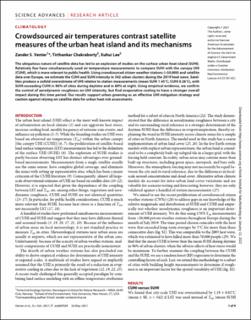Crowdsourced air temperatures contrast satellite measures of the urban heat island and its mechanisms
Peer reviewed, Journal article
Published version

Åpne
Permanent lenke
https://hdl.handle.net/11250/2987445Utgivelsesdato
2021Metadata
Vis full innførselSamlinger
- Publikasjoner fra CRIStin - NINA [2364]
- Scientific publications [1392]
Sammendrag
The ubiquitous nature of satellite data has led to an explosion of studies on the surface urban heat island (SUHI). Relatively few have simultaneously used air temperature measurements to compare SUHI with the canopy UHI (CUHI), which is more relevant to public health. Using crowdsourced citizen weather stations (>50,000) and satellite data over Europe, we estimate the CUHI and SUHI intensity in 342 urban clusters during the 2019 heat wave. Satellites produce a sixfold overestimate of UHI relative to station measurements (mean SUHI 1.45°C; CUHI 0.26°C), with SUHI exceeding CUHI in 96% of cities during daytime and in 80% at night. Using empirical evidence, we confirm the control of aerodynamic roughness on UHI intensity, but find evaporative cooling to have a stronger overall impact during this time period. Our results support urban greening as an effective UHI mitigation strategy and caution against relying on satellite data for urban heat risk assessments.
